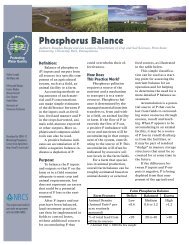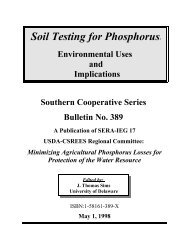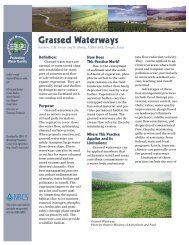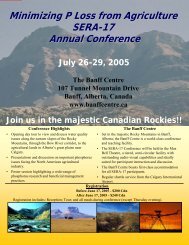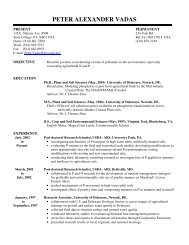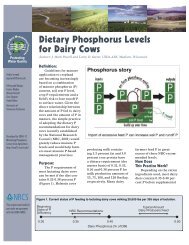Processes and BMPs Controlling P Loss During Snowmelt: Snow and ...
Processes and BMPs Controlling P Loss During Snowmelt: Snow and ...
Processes and BMPs Controlling P Loss During Snowmelt: Snow and ...
You also want an ePaper? Increase the reach of your titles
YUMPU automatically turns print PDFs into web optimized ePapers that Google loves.
<strong>Processes</strong> <strong>and</strong> <strong>BMPs</strong> <strong>Controlling</strong><br />
P <strong>Loss</strong> <strong>During</strong> <strong><strong>Snow</strong>melt</strong>:<br />
<strong>Snow</strong> <strong>and</strong> Rain<br />
are not the Same<br />
Don Flaten, University of Manitoba<br />
Great Lakes P Forum/SERA-17 Annual Meeting<br />
July 29, 2009 - Windsor, Ontario<br />
Photo: David Lobb
Assigned Questions<br />
1. Do we know the seasonality <strong>and</strong><br />
magnitude of P losses in different<br />
temperate <strong>and</strong> continental cold<br />
climates?<br />
2. How do frozen soils <strong>and</strong> hydrology<br />
affect the relative proportions of<br />
dissolved <strong>and</strong> particulate P during<br />
spring freshet?<br />
3. Do we sufficiently know the<br />
interactions between field<br />
management <strong>and</strong> winter/spring<br />
melt P losses to develop more<br />
effective <strong>BMPs</strong>?
First, a few caveats ...<br />
some of my biases
Lake Winnipeg - the<br />
6th Great Lake
Manitoba l<strong>and</strong>scapes are flatter <strong>and</strong> the weather is<br />
dryer <strong>and</strong> colder than in the Great Lakes region<br />
• Flat – low risk of water erosion<br />
• Dry – < 500 mm precipitation/year<br />
• Cold – 80-90% of runoff as snowmelt, over thawing<br />
vegetative residues <strong>and</strong> frozen soil
1. Do we know the seasonality <strong>and</strong><br />
magnitude of P losses in different<br />
temperate <strong>and</strong> continental cold<br />
climates?<br />
2. How do frozen soils <strong>and</strong> hydrology<br />
affect the relative proportions of<br />
dissolved <strong>and</strong> particulate P during<br />
spring freshet?
Rainfall Runoff System for P <strong>Loss</strong><br />
Rainfall:<br />
Infiltration<br />
<strong>and</strong><br />
Percolation<br />
Soil Erosion:<br />
(Particulate P)<br />
Release of Soluble P<br />
to Runoff<br />
Surface Runoff:<br />
(Dissolved P)<br />
Total Surface<br />
P <strong>Loss</strong>:<br />
Particulate +<br />
Dissolved P<br />
Near- <strong>and</strong> In-stream<br />
<strong>Processes</strong><br />
P Leaching <strong>and</strong><br />
Subsurface Runoff<br />
Effective Depth of<br />
Interaction (< 5 cm)<br />
(Adapted from Wood 1998)
<strong><strong>Snow</strong>melt</strong> Runoff System for P <strong>Loss</strong>:<br />
<strong>Snow</strong> Accumulation Phase<br />
No "raindrop"<br />
splash<br />
Frozen Soil?<br />
Dead or dormant<br />
vegetation in fields <strong>and</strong><br />
buffers
<strong><strong>Snow</strong>melt</strong> Runoff System for P <strong>Loss</strong>:<br />
<strong><strong>Snow</strong>melt</strong> Phase<br />
<strong><strong>Snow</strong>melt</strong>:<br />
Little<br />
Infiltration or<br />
Percolation<br />
Release of soluble P<br />
to runoff from soil<br />
<strong>and</strong> veg. residues<br />
Soil Erosion:<br />
(Particulate P)<br />
Little P Leaching<br />
<strong>and</strong> Subsurface<br />
Runoff<br />
Surface Runoff:<br />
(Dissolved P)<br />
Shallow Effective Depth<br />
of Interaction (< 2.5 cm)<br />
Total Surface<br />
P <strong>Loss</strong>:<br />
Particulate +<br />
Dissolved P<br />
Near- <strong>and</strong> In-stream<br />
<strong>Processes</strong><br />
Frozen Soil?
<strong>Snow</strong> accumulation is highly variable ...<br />
usually greater in <strong>and</strong> near streams<br />
Photo: David Lobb
Clearing accumulations of snow <strong>and</strong> ice<br />
from drainage channels during snowmelt<br />
April 2009 near Selkirk, Manitoba
Accumulations of snow block <strong>and</strong> divert<br />
"natural" drainage<br />
Photos: David Lobb
Monitoring vegetated buffers ...<br />
bring snowshoes<br />
Photo: S. Sheppard
Water quality sampling in vegetated buffers<br />
during snowmelt<br />
Photo: Stephen Carlyle, Gimli, Manitoba, March-April 2009
Effective depth of interaction between runoff <strong>and</strong><br />
soil is shallow <strong>and</strong> temporally/spatially variable<br />
Photos: David Lobb
Significant amounts of<br />
soil erosion may still<br />
occur during snowmelt<br />
... especially when soil<br />
is highly saturated,<br />
partially thawed, <strong>and</strong><br />
bare
What are the functions of in <strong>and</strong> near stream<br />
processes during snowmelt?<br />
Photo: David Lobb
<strong><strong>Snow</strong>melt</strong> runoff in Minnesota<br />
Photos: Wall, Dave. How does the MN P index relate to MPCA policies?<br />
http://www.mnpi.umn.edu/downloadfiles/Pindex<strong>and</strong>feedlotrules.pdf
<strong><strong>Snow</strong>melt</strong> Runoff in Ohio<br />
March 1, 2007<br />
February 26, 2007<br />
Photos: Wilson, Rick. 2007. Phosphorus: A Summary of Pertinent Research.<br />
http://www.epa.state.oh.us/dsw/lakeerie/ptaskforce/PTaskRW091007.pdf
<strong><strong>Snow</strong>melt</strong> runoff is relatively slow <strong>and</strong> complex<br />
Streamflow <strong>During</strong> Rainfall Runoff Events<br />
Streamflow <strong>During</strong> <strong><strong>Snow</strong>melt</strong> Runoff Events<br />
Glozier et al. 2006. Water quality characteristics <strong>and</strong> trends in a small<br />
agricultural watershed: South Tobacco Creek, Manitoba, 1992-2001.
Diurnal pattern of snowmelt runoff in<br />
Sweden (Ulen 2003)
Proportion of P in the dissolved form in snowmelt<br />
runoff in streams is relatively high <strong>and</strong> stable<br />
Ratio TDP/TP<br />
1.0<br />
0.8<br />
0.6<br />
0.4<br />
0.2<br />
0.0<br />
y = -0.0399x + 0.4512<br />
R 2 = 0.3526<br />
y = -0.0095x + 0.6121<br />
R 2 = 0.0661<br />
0 2 4 6 8 10 12 14 16 18 20 22<br />
Flow, m 3 /s<br />
<strong><strong>Snow</strong>melt</strong><br />
Summer<br />
Adapted from Glozier et al. 2006. Water quality characteristics <strong>and</strong> trends<br />
in a small agricultural watershed: South Tobacco Creek, Manitoba, 1992-<br />
2001.
Proportion of dissolved P in edge of field compared<br />
to nearby stream is especially high in dissolved P <strong>and</strong><br />
low in particulate P<br />
1<br />
0.8<br />
<strong><strong>Snow</strong>melt</strong><br />
Summer<br />
Ratio TDP/TP<br />
0.6<br />
0.4<br />
0.2<br />
0<br />
Edge of Field<br />
Stream<br />
Elliott et al. 2007 (unpublished)
Predominance of dissolved P is often<br />
greatest in early portion of snowmelt runoff<br />
The proportion of the<br />
soluble reactive<br />
phosphorus (SRP) of<br />
the total phosphorus<br />
concentration for<br />
snowmelt runoff in<br />
Finl<strong>and</strong> (Rekolainan<br />
et al. 1989).
Addressing snowmelt P loss in P indexes<br />
<strong>and</strong> models: Minnesota P Index<br />
Assumes that 18% of applied P <strong>and</strong> crop residue P is lost per inch of runoff
3. Do we sufficiently know the<br />
interactions between field management<br />
<strong>and</strong> winter/spring melt P losses to<br />
develop more effective <strong>BMPs</strong>?
What BMP tools do we expect farmers to use?<br />
• Source <strong>BMPs</strong><br />
• P balance, rate application, STP<br />
• Placement, timing of manure <strong>and</strong><br />
synthetic fertilizer application<br />
• Conservation tillage?<br />
• Transport <strong>BMPs</strong><br />
• Conservation tillage?<br />
• Vegetated buffers<br />
• Cover crops<br />
• Constructed wetl<strong>and</strong>s <strong>and</strong> small<br />
reservoirs
At high levels of STP, STP is strongly related to total P<br />
concentrations in runoff<br />
10<br />
9<br />
0 to 15 cm<br />
0 to 2.5 cm<br />
b<br />
8<br />
0 to 15 cm<br />
TP FWMC (mg L -1 )<br />
7<br />
6<br />
5<br />
4<br />
3<br />
2<br />
0 to 2.5 cm<br />
TP = 0.014 * STP (0-15 cm) + 0.16<br />
r 2 = 0.88<br />
TP = 0.013 * STP (0-2.5 cm) + 0.039<br />
r 2 = 0.87<br />
1<br />
0<br />
0 100 200 300 400 500 600<br />
Typical Prairie<br />
STP value<br />
STP (mg kg -1 )<br />
Little, J.L, Nolan, S.C, Casson, J.P. <strong>and</strong> Olson, B.M. 2007. Relationships between soil <strong>and</strong><br />
runoff phosphorus in small Alberta watersheds. J. Envir. Qual. (2007). <strong><strong>Snow</strong>melt</strong> > 90% of<br />
runoff, DP = 55 % of TP, Modified Kelowna STP extraction method.
At low levels of STP, STP is not related to total P<br />
concentrations in runoff from Alberta watersheds<br />
1.8<br />
FWMC TP (mg/L)<br />
1.6<br />
1.4<br />
1.2<br />
1<br />
0.8<br />
0.6<br />
0.4<br />
0.2<br />
native rangel<strong>and</strong><br />
cultivated cropl<strong>and</strong><br />
Native prairie in Minnesota yielded average<br />
of 0.5 mg/L TP in runoff where 80% of runoff<br />
was snowmelt ... rainfall runoff averaged 0.7<br />
mg/L (Timmons & Holt 1977)<br />
spring 2003<br />
summer 2003<br />
spring 2004<br />
summer 2004<br />
spring 2005<br />
summer 2005<br />
0<br />
0 20 40 60 80 100<br />
Typical Prairie<br />
STP value<br />
Modified Kelowna P (mg/kg)<br />
Adapted from Little, J.L, Nolan, S.C, Casson, J.P. <strong>and</strong> Olson, B.M. 2007. Relationships<br />
between soil <strong>and</strong> runoff phosphorus in small Alberta watersheds. J. Envir. Qual. (2007).<br />
<strong><strong>Snow</strong>melt</strong> > 90% of runoff, DP = 55 % of TP, Modified Kelowna STP extraction method.
Time <strong>and</strong> method of nutrient application<br />
• Manure or fertilizer on frozen soil or snow is bad<br />
agronomically <strong>and</strong> environmentally … especially<br />
where snowmelt forms a large proportion of<br />
runoff (eg. Srinivisan et al. 2006, Klausner 1976,<br />
Young & Mutchler 1976)<br />
• Injected, b<strong>and</strong>ed, or incorporated applications<br />
are recommended, especially for fall application
Conventional vs. conservation tillage in<br />
snowmelt systems - South Tobacco<br />
Creek WEBs project in Manitoba
Twin watershed study - average annual P loading from<br />
zero till were greater than losses from conventional till ...<br />
<strong>and</strong> dissolved P losses dominated in both<br />
P loss (lb P 2 O 5 /ac/yr)<br />
1.4<br />
1.2<br />
1.0<br />
0.8<br />
0.6<br />
0.4<br />
0.2<br />
0.0<br />
Dissolved P<br />
Particulate P<br />
Zero till management<br />
started in fall 1996<br />
CT “ZT” CT ZT<br />
1993-1996 2004-2007<br />
(Tiessen et al. unpublished)
ANCOVA showed that conservation tillage<br />
increased average annual total P export by 12%<br />
0.40<br />
calibration period<br />
Linear (calibration period)<br />
treatment period<br />
Linear (treatment period)<br />
Treatment watershed<br />
(ZT_EW) (kg/ha)<br />
0.35<br />
0.30<br />
0.25<br />
0.20<br />
0.15<br />
0.10<br />
0.05<br />
y = 1.12x + 0.02<br />
R 2 = 0.70*<br />
1:1 line<br />
y = 0.72x + 0.03<br />
R 2 = 0.62*<br />
0.00<br />
0.00 0.05 0.10 0.15 0.20 0.25 0.30 0.35<br />
Control watershed<br />
(CT_WW) (kg/ha)
Effect of zero tillage vs. conventional tillage<br />
varied with season <strong>and</strong> water quality parameter<br />
Runoff<br />
Export<br />
Parameter<br />
Rainfall Runoff<br />
Ranking*<br />
Means**<br />
ZT CT<br />
Runoff (m 3 /ha/yr) ZT < CT 80 173<br />
Sediment (kg/ha/yr) ZT < CT 11 25<br />
PP (kg/ha/yr) ZT < CT 0.019 0.034<br />
TDP (kg/ha/yr) ns 0.052 0.046<br />
TP (kg/ha/yr) ns 0.071 0.080<br />
* Differences in rankings determined by Kruskal-Wallace non-parametric test<br />
** Means are simple arithmetic means for the post-treatment period (2004-2007)<br />
Tiessen et al. 2009 (unpublished)
Effect of zero tillage vs. conventional tillage<br />
varied with season <strong>and</strong> water quality parameter<br />
Runoff<br />
Export<br />
Parameter<br />
Rainfall Runoff<br />
Ranking*<br />
Means**<br />
ZT CT<br />
<strong><strong>Snow</strong>melt</strong> Runoff<br />
Ranking<br />
Means<br />
ZT CT<br />
Runoff (m 3 /ha/yr) ZT < CT 80 173 ns 727 730<br />
Sediment (kg/ha/yr) ZT < CT 11 25 ZT < CT 10 65<br />
PP (kg/ha/yr) ZT < CT 0.019 0.034 ns 0.085 0.096<br />
TDP (kg/ha/yr) ns 0.052 0.046 ZT > CT 0.493 0.212<br />
TP (kg/ha/yr) ns 0.071 0.080 ZT > CT 0.578 0.308<br />
* Differences in rankings determined by Kruskal-Wallace non-parametric test<br />
** Means are simple arithmetic means for the post-treatment period (2004-2007)<br />
Tiessen et al. 2009 (unpublished)
Other experiences with conservation tillage<br />
in snowmelt runoff systems<br />
Ridge tillage in<br />
Minnesota<br />
decreased<br />
sediment loss<br />
relative to chisel,<br />
but increased TP<br />
loss ... runoff P<br />
losses for all tillage<br />
systems were<br />
dominated by DP<br />
(avg. 75%)<br />
Hansen et al. 2000
Vegetated buffer strips not as effective as<br />
expected in SE Manitoba (Sheppard et al. 2006)<br />
• DP = 74% of TP, snowmelt dominant runoff<br />
• VBS reduced runoff [TP] in 50% of cases,<br />
increased P in 18%, had no effect in 32%<br />
• overall average only 4% reduction in runoff [TP]<br />
Photo: Steve Sheppard
Other experiences with vegetated buffers<br />
<strong>and</strong> perennial forages in snowmelt runoff<br />
• In Finl<strong>and</strong>, no reduction in P loss from perennial<br />
forage vs. cultivated field in dissolved <strong>and</strong> colloidal<br />
P dominated snowmelt runoff (Ulen 2003)<br />
• In Pennsylvania runoff simulator studies:<br />
– without freezing, cover crop decreased runoff<br />
[TP] from manured soil by 76%<br />
– after freezing & thawing, cover crop increased<br />
[TP] in runoff from manured soil by 762%<br />
– water extractability of P increased with number<br />
of freeze-thaw cycles (Bechmann et al. 2006)
Other experiences with vegetated buffers<br />
<strong>and</strong> perennial forages in snowmelt runoff<br />
• In Wisconsin, P loss from alfalfa increased with<br />
freeze-thaw, as well as natural or chemical<br />
dessication in simulated runoff ... but not in<br />
natural runoff (Roberson et al. 2007)<br />
• In Vermont, vegetated buffers intercepted dairy<br />
barnyard runoff P well during growing season,<br />
but not in fall-winter or snowmelt periods<br />
(Schellinger <strong>and</strong> Clausen 1992)<br />
• In Finl<strong>and</strong>, 32 P labelling indicated only 16%<br />
retention of P in vegetated buffers during<br />
snowmelt, with almost all retention by soil<br />
particles (Vaananen et al. 2006)
Small reservoirs reduce sediment <strong>and</strong><br />
nutrient loading in snowmelt systems<br />
eg. small reservoir in South<br />
Tobacco Creek WEBS<br />
project reduced loads of:<br />
– sediment (77%)<br />
– TN (15%), TDN (14%)<br />
– TP (12%), TDP (10%)<br />
– mechanisms?
Summary <strong>and</strong> Conclusions<br />
• <strong>Processes</strong> controlling P loss in snowmelt runoff<br />
are not well known … partly because of extreme<br />
spatial <strong>and</strong> temporal variability during snowmelt<br />
runoff events<br />
Photo: David Lobb
Summary <strong>and</strong> Conclusions, cont’d.<br />
• <strong>BMPs</strong> for controlling P loss in snowmelt runoff<br />
are not well developed ... partly because the high<br />
proportion of dissolved <strong>and</strong> colloidal P is<br />
difficult to intercept, especially when soil is<br />
frozen <strong>and</strong> plants are dead or dormant<br />
– Source <strong>BMPs</strong><br />
» P balance, soil test P are important,<br />
but vegetative residues <strong>and</strong> "fresh<br />
frozen" manure are very important<br />
sources during snowmelt<br />
– Transport <strong>BMPs</strong><br />
» if erosion is not the main cause of P<br />
loss, erosion control measures will<br />
do little to reduce P loss
Investing in Additional Research ...<br />
http://umanitoba.ca/cgi-bin/human_resources/jobs/view.pl?posting_id=82345
Summary <strong>and</strong> Conclusions, cont’d.<br />
• In the interim, focus farmers' efforts <strong>and</strong> public<br />
policy on the most obvious P source/loading<br />
issues … eg. balance P application with removal<br />
<strong>and</strong> avoid winter application of nutrients
Acknowledgements<br />
• Kevin Tiessen, David Lobb, Darshani<br />
Kumaragamage, Clay Sawka, Esther Salvano, U of M<br />
• Jane Elliott, Nancy Glozier, Environment Canada<br />
• Steve Sheppard, Ecomatters<br />
• Jim Yarotski, AAFC-PFRA <strong>and</strong> WEBs manager<br />
• Bill Turner, Deerwood Soil & Water Mgmt. Ass'n.<br />
• Sheilah Nolan, Alberta Agric., Food <strong>and</strong> Rural Dev.



